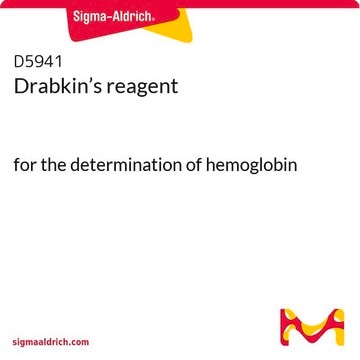The website indicates that the product H2500 is mainly methemoglobin. A search of the website did not uncover any products marketed as either ferrohemoglobin or oxyhemoglobin.
H2500
Hemoglobin from bovine blood
lyophilized powder
Sinonimo/i:
Bovine hemoglobin, Hb, Methemoglobin
About This Item
Prodotti consigliati
Origine biologica
bovine blood
Stato
lyophilized powder
PM
Mr ~64500
tecniche
MALDI-TOF: suitable
Temperatura di conservazione
2-8°C
Informazioni sul gene
cow ... HBA1(281221) , HBB(280813) , HBE2(513240) , HBE4(513108) , HBG(511735) , alpha globin(512439)
Cerchi prodotti simili? Visita Guida al confronto tra prodotti
Descrizione generale
Applicazioni
- standard curve generation for the quantification intraparenchymal hemorrhage[2] and parenchymal hemorrhage[3] in spinal cord homogenate using Drabkin′s assay, Quadrupole-Ion Mobility-Time-of-Flight mass spectrometery [4]
- the generation of molecularly imprinted polymers (MIPs) to mimic high molecular-weight polyethylene glycol (PEG) in crystallization studies[5]
Azioni biochim/fisiol
Avvertenza
Applicazioni
Codice della classe di stoccaggio
11 - Combustible Solids
Classe di pericolosità dell'acqua (WGK)
WGK 3
Punto d’infiammabilità (°F)
Not applicable
Punto d’infiammabilità (°C)
Not applicable
Dispositivi di protezione individuale
Eyeshields, Gloves, type N95 (US)
Scegli una delle versioni più recenti:
Certificati d'analisi (COA)
Non trovi la versione di tuo interesse?
Se hai bisogno di una versione specifica, puoi cercare il certificato tramite il numero di lotto.
Possiedi già questo prodotto?
I documenti relativi ai prodotti acquistati recentemente sono disponibili nell’Archivio dei documenti.
I clienti hanno visto anche
-
Does the website specify if H2500 Hemoglobin from bovine blood is ferrohemoglobin or oxyhemoglobin?
1 risposta-
Utile?
-
-
What is the difference between H2500 and H2625 when making Chocolate agar with bovine hemoglobin? Although they share the same CAS and Specification Sheet, there is a significant difference in price between the two.
1 risposta-
Products H2500 and H2625 are not suitability tested for use in producing Chocolate Agar. The key differences between H2500 and H2625 lie in their purity and intended uses. H2500 is a purer product, suitable for MALDI-TOF, and associated with a companion product for HPLC analysis of hemoglobin variants. It undergoes two steps of ammonium sulfate precipitation, filtration, dialysis, and lyophilization. On the other hand, H2625 is not suitability tested for use as a protease substrate and lacks the ammonium sulfate precipitation step. These distinctions likely contribute to the significant price difference between the two products.
Utile?
-
Filtri attivi
Il team dei nostri ricercatori vanta grande esperienza in tutte le aree della ricerca quali Life Science, scienza dei materiali, sintesi chimica, cromatografia, discipline analitiche, ecc..
Contatta l'Assistenza Tecnica.








